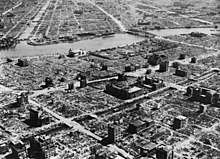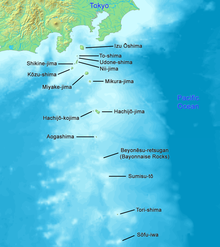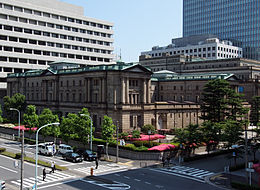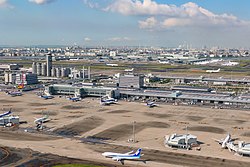Tokyo
Beginning in the late 1940s, Tokyo underwent rapid reconstruction and expansion, which fueled the Japanese economic miracle, in which Japan's economy became the second largest in the world at the time, behind that of the United States.During the subsequent Jomon period, the Holocene glacial retreat caused sea levels in Tokyo Bay to rise by 120 cm, with the coastline running along the edge of what is now the Imperial Palace.While the Tokugawa shogunate ruled the country in practice, the Imperial House of Japan was still the de jure ruler, and the title of shōgun was granted by the Emperor as a formality.Commodore Perry forced the opening of the ports of Shimoda and Hakodate, leading to an increase in the demand for new foreign goods and subsequently a severe rise in inflation.[40] Meanwhile, supporters of the Emperor leveraged the disruption caused by widespread rebellious demonstrations to further consolidate power, which resulted in the overthrow of the last Tokugawa shōgun, Yoshinobu, in 1867.Hisoka Maejima advocated for the relocation of the capital functions to Tokyo, recognizing the advantages of the existing infrastructure and the vastness of the Kanto Plain compared to the relatively small Kyoto basin.This turmoil eventually allowed the military wings of the government to take control of the country, leading to Japan joining the Second World War as an Axis power.Due to the country's political isolation on the international stage caused by its military aggression in China and the increasingly unstable geopolitical situations in Europe, Тоkуо had to give up hosting the 1940 Summer Olympics in 1938.Although Japan enjoyed significant success in the initial stages of the war and rapidly expanded its sphere of influence, the Doolittle Raid on 18 April 1942, marked the first direct foreign attack on Tokyo.[67] West Shinjuku, which had been occupied by the vast Yodobashi Water Purification Centre until 1965, became the site of an entirely new business district characterized by skyscrapers surpassing 200 metres during this period.[68] The American-led Plaza Accord in 1985, which aimed to depreciate the US dollar, had a devastating effect on Japan's manufacturing sector, particularly affecting small to mid-size companies based in Tokyo.Recent projects include Ebisu Garden Place, Tennōzu Isle, Shiodome, Roppongi Hills, Shinagawa, and the Marunouchi side of Tokyo Station.It is not uncommon in the metro area to have hundreds of these minor quakes (magnitudes 4–6) that can be felt in a single year, something local residents merely brush off but can be a source of anxiety not only for foreign visitors but for Japanese from elsewhere as well.[124] According to the government, less than a millimeter of the volcanic ash from a Mount Fuji eruption could cause power grid problems such as blackouts and stop trains in the Tokyo metropolitan area.[126] Tokyo's buildings are too diverse to be characterized by any specific architectural style, but it can be generally said that a majority of extant structures were built in the past a hundred years;[128] twice in recent history has the metropolis been left in ruins: first in the 1923 Great Kantō earthquake and later after extensive firebombing in World War II.[133] None of the grand Edo-era daimyo houses still exist in Tokyo, as their vast land footprint made them easy targets for redevelopment programs for modernization during the Meiji Period.The Akamon, which is now widely seen as a symbol of the University of Tokyo, was originally built to commemorate the marriage of a shogun's daughter into the Maeda clan, one of the most affluent of the feudal lords, while the campus itself occupies their former edo estate.[134]The Meiji era saw a rapid modernization in architectural styles as well; until the Great Kanto Earthquake in 1923 exposed their weakness to seimic shocks, grand brick buildings were constantly built across the city.The Imperial Crown Style, which often features Japanese-style roofs on top of elevated concrete structures, was adopted for the Tokyo National Museum in Ueno and the Kudan Hall in Kudanminami.[157] Tokyo was rated by the Economist Intelligence Unit as the most expensive (highest cost-of-living) city in the world for 14 years in a row ending in 2006, when it was replaced by Oslo, and later Paris.[158][159] However, years of deflation and an extremely weak yen starting in 2022 due to Japan's low interest rates made the cost of living in Tokyo 31% cheaper than in New York City in 2023, which is roughly the same as in Beijing and Manchester according to the 2023 EIU rankings.[161] Tokyo is a major international finance center;[162] it houses the headquarters of several of the world's largest investment banks and insurance companies, and serves as a hub for Japan's transportation, publishing, electronics and broadcasting industries.During the centralized growth of Japan's economy following World War II, many large firms moved their headquarters from cities such as Osaka (the historical commercial capital) to Tokyo, in an attempt to take advantage of better access to the government.Major publishers based in Tokyo include Shueisha, Kodansha, Kadokawa, Shogakukan, Bungeishunju, Shinchosha, and Iwanami Shoten, with a high concentration in Chiyoda and Shinjuku.Retailers, whole-sellers, auctioneers, and public citizens alike frequent the market, creating a unique microcosm of organized chaos that still continues to fuel the city and its food supply after over four centuries.With 36% of its area covered by forest, Tokyo has extensive growths of cryptomeria and Japanese cypress, especially in the mountainous western communities of Akiruno, Ōme, Okutama, Hachiōji, Hinode, and Hinohara.Public transportation within Tokyo is dominated by an extensive network of "clean and efficient"[175] trains and subways run by a variety of operators, with buses, monorails and trams playing a secondary feeder role.The total length of the Shuto Expressway is 337.8 km, with speed limits usually set at 80 km/h or 60 km/h to reduce noise pollution and accommodate the relatively winding road shapes.[202] Early-modern-established academies such as Gakushuin and Keio provide all-through educational programs from primary schools to universities, originally to cater to the needs of traditionally affluent and powerful families.Odaiba, a man-made island in Tokyo Bay, features shopping, dining and entertainment attractions such as the teamLab Planets digital art museum and Joypolis indoor amusement park.


























Tokyo (disambiguation)Capital citymetropolisNishi-ShinjukuMount FujiTokyo SkytreeRainbow BridgeTokyo TowerShibuya CrossingNational Diet BuildingImperial PalaceTokyo StationEmblemRegionKantōIslandHonshuCapitalShinjuku23 special wards26 cities1 district4 subprefecturesTokyo Metropolitan GovernmentGovernorYuriko KoikeRepresentativesCouncilors45th in Japan1st in JapanNorthern Izu IslandsDemonymTime zoneJapan Standard TimeYoshino cherryGinkgoBlack-headed gullcity properone of the most populous urban areas in the worldGreater Tokyo AreaprefecturesTokyo BayKantō regionJapanese governmentEmperor of JapanTokyo Cityits western areaTokyo IslandsAssemblyChiyodaTokyo Imperial PalaceShibuyaTokugawa shogunateMeiji RestorationEastern CapitalGreat Kantō earthquakeallied bombing raidsWorld War IIJapanese economic miracleJapan's economysecond largest in the world at the timethat of the United StatesFortune Global 500Summer OlympicsParalympicsresearch and developmentseveral major universitiesUniversity of TokyoShinkansenShinjuku StationTokyo Metro Ginza Lineoldest underground metro lineAsia–Pacificsecond-largest metropolitan economy in the worldNew YorkLost DecadesTokyo Stock Exchangeworld's top five major stock exchangesAlpha+ cityGlobalization and World Cities Research NetworkGlobal Livability RankingHiraganaKatakanaRevised HepburnKunrei-shikiestuarySumida RiverKeijōBeijingNanjingXijingMeiji periodkanji homographHistory of TokyoTimeline of TokyoPaleolithic periodJomon periodHolocene glacial retreatOmori Shell MoundsYayoi periodYayoi 2-chōme SiteBunkyoYayoi potteryShozo ArisakaKuni no MiyatsukoEmperor AnkanSenso-jiRitsuryō systemAsuka periodMusashi ProvinceKingdom of BaekjeBattle of BaekgangHeian periodEdo clanŌta DōkanEdo CastleChiba clanUesugi clanLater Hōjō clanBattle of TakanawaharaToyotomi HideyoshiSiege of OdawaraPerry ExpeditionBakumatsuMitsukoshiNihonbashi






